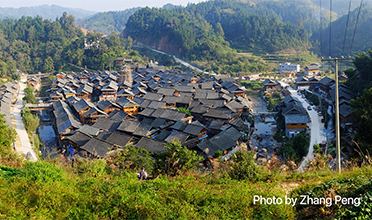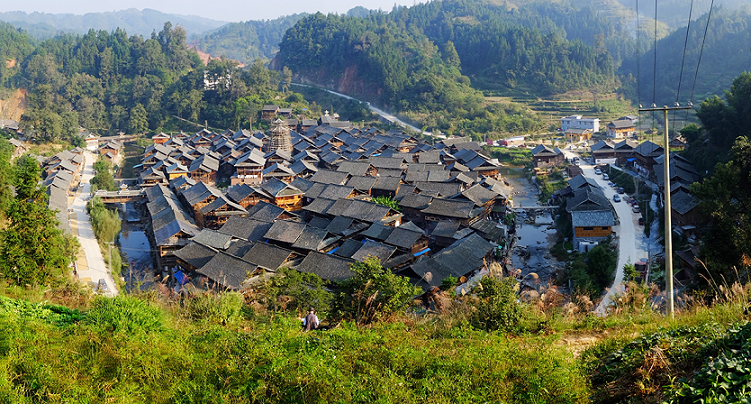



[Photo by Zhang Peng]
2.2 Evolution of human-land relations in villages
When the productivity level of human beings had not been greatly improved, and the natural environment had not been transformed by human beings according to their production and living habits, the human-land relationship in villages could be seen as a sparse population settled in the wide tracts of land. At that time, human production, people’s life and basic needs were limited by natural conditions. However, with the continuous improvement of people's production and living standards, this traditional human-land relationship has gradually changed. Nowadays, the cultural connotation of traditional villages, not only refers to the forms of bridges, towers, drum towers, human settlements, and other constructions, but also describe villages in a more holistic and dynamic way. Because the "human-land relationship" has changed, in the past is "dweller lives off the land", while now gradually transformed into "human live on the land and develop the land". In other words, with the present level of human production, we can quickly transform nature and the environment. For example, in Zengchong Village, the location of the new village no longer takes into account the mountain form and the importance of the water system, but simply follows the rules of the moment and the rigid planning method to carry out the construction. In addition, the construction of "beautiful countryside" has evolved into a kind of performance indicator. Beautiful countryside building needs to construct the drainage facilities and garbage disposal facilities that are at odds with the traditional daily lifestyle of the people, so that they are abandoned after completion, resulting in a waste of resources.
2.3 Traditional villages: New development challenges
Traditional village development is now confronting three new types of challenges: physical, institutional, and spiritual challenges. On the physical side, the traditional environment within villages is decaying, and the gap between urban and rural areas is gradually widening. For example, in terms of medical care, education and other resources, the level of development in cities is much higher than that in villages. On the institutional side, the rural hollowing of villages as a result of rapid urbanization has led to the disintegration of rural communities, the loss of talents, and a lack of self-organizing ability. Spiritually, the cultural diversity of the countryside has decreased, and the rural culture that nourishes the spirit is fading. A large number of traditional villages are facing the threat of being transformed or decayed by alienation.
2.4 Significance of traditional village conservation
Nowadays, people are revisiting the traditional vernacular wisdom and preserving the rural heritage, neither to analyze its historical and cultural value nor to copy such traditional wisdom. Rather, it is about learning to better handle valuable natural and cultural resources and to manage and satisfy people's own diverse needs in the context of a new human-land relationship. Therefore, we can explore the contemporary vernacular wisdom for the sustainable development of rural settlements.
3 Cultural protection empowering traditional village rural revitalization
Cultural preservation empowers traditional village rural revitalization with a double meaning: on the one hand, empowerment through the protection and adaptive use of culture and natural resources, corresponding to the industrial revitalization policy and ecological revitalization policy in the rural revitalization strategy. On the other hand, is to empower in a cultural way, learning from the original deep material, institutional and spiritual culture of the countryside, which corresponds to the revitalization policies of human resources, organizational revitalization and cultural revitalization.
3.1 Establishment of cultural confidence and cultural self-improvement
When protecting and constructing traditional villages, cultural self-confidence should be possessed. Each village can survive and form such a good tangible and intangible heritage, concentrating thousands of years of ancestors’ wisdom, which needs to be discovered. People should understand the value in-depth, and to give full play to the culturally nurturing and educational role of the rural culture. For example, when we develop it as a cultural tourism industry, more comprehensive objectives should be considered, such as economic, ecological, and cultural aspects. The ways of village development used to be result-oriented, while now change to a more process-oriented approach. In such a process, it is necessary to see whether the awareness of the villagers and their impact on society has been further enhanced. In terms of the direction of village development, it shifts from the present catering orientation to a guiding orientation, leading tourists and residents to learn and explore on their own initiative, thus enabling them to have a more in-depth experience. Besides, we also need cultural self-improvement, that is, we should fully recognize the vulnerability of traditional villages and build a rural revitalization strategy of holistic conservation and synergistic development.
3.2 The overall protection and synergistic development of southern Anhui region
South Anhui region retains a lot of ancient villages with beautiful scenery, such as Xidi, Hongcun, Nanping, etc. The data in 2012 shows that Xidi and Hongcun have a particularly large number of tourists every year, but others are often ignored by tourists. In this regard, we did a survey and found that historically there were very many ancient villages in southern Anhui, they formed a whole rural cultural system, but at present only Xidi, Hongcun ancient village included in the world heritage site. Therefore these two villages’ tourism revenue is indeed far greater than other villages. At the same time, the layout of the villages is point-like and decentralized, and the sub-cultures within the South Anhui region are rather vague, thus people have formed a single image of South Anhui in general.

Figure 8: Distribution of natural resources in South Anhui region
By means of planning, firstly, planners associated the scattered points of cities, towns, villages, neighbourhoods and buildings. Then, we linked up the river network waterways, ancient stagecoach routes and other cultural routes. And finally, we clustered similar patches according to topography and regional culture. We formed a framework map for the protection and inheritance of the history and culture of Southern Anhui eventually, covering three spatial levels, namely, cultural districts, cultural units and cultural nodes. After these villages form an overall system, there has been a slow shift from the previous fragmentation and even the existence of unfair competition among the various cultural units to a synergistic and cooperative approach. The mechanism has even produced some cross-regional, cross-provincial, cross-city approaches.
Author:Shao YongDeputy Secretary-General of Historical and Cultural Cities Planning Branch of the Urban Planning Society of China
Professor, College of Architecture and Urban Planning, Tongji University
Source: <https://mp.weixin.qq.com/s/sU0bvg02NdB3jM9SlPi7YA>
Translated by Zhang Chenxi